LinkedIn is a leading social network for brands looking to gain authority, build their network and connect with potential customers. With 82% of B2B marketers achieving their greatest success on LinkedIn, it’s clear that LinkedIn is a preferred channel for B2B marketing.
With so many brands competing for users’ attention, managing and growing a LinkedIn account takes enormous time, dedication and effort. To stand out, you need to post consistently and at the right times. That’s where social media scheduling tools come in.
In this guide, we’ll show you how to schedule posts on LinkedIn. You’ll also find helpful scheduling tips for maximizing the reach and engagement of your posts.
Can you schedule posts on LinkedIn?
Yes, you can schedule posts on LinkedIn in two ways. The first is through LinkedIn’s native scheduling tool, which is available to all users and lets you schedule posts directly within the platform while you’re creating drafts.
Alternatively, you can use a social media management tool like Sprout Social to schedule your posts. This way, you can also benefit from Sprout’s other capabilities, like automation, analytics and AI writing assistance, to amplify your LinkedIn marketing strategy.
How to schedule posts natively on LinkedIn
LinkedIn’s native scheduling tool is a convenient, built-in feature that lets you plan and schedule your posts ahead of time without leaving the platform or relying on third-party tools. Here’s how to do it:
1. Log in to your LinkedIn account and click the Start a post box at the top of your feed.

2. When Create a post pops up, enter the body text of your post and attach any images, videos or documents. You can also create a poll if you want. If you’re posting a video, you can add subtitles by enabling auto-captions (English-language videos only) or uploading an SRT file.
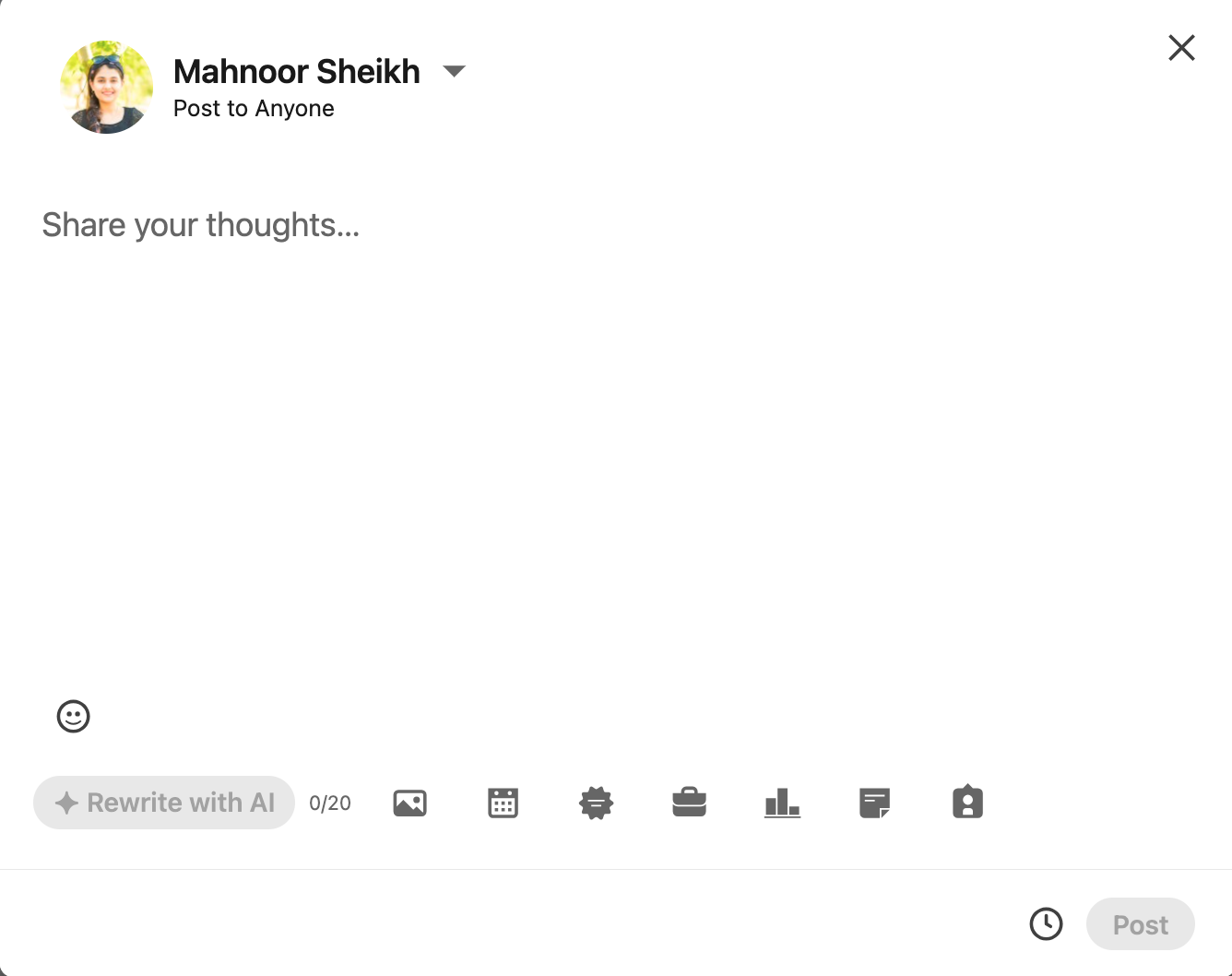
3. Click the Clock icon in the lower right corner to open the schedule dialog.
4. In the scheduling dialog, select a date and time to schedule your post. If your audience is in a different time zone, consider scheduling in their time zone.
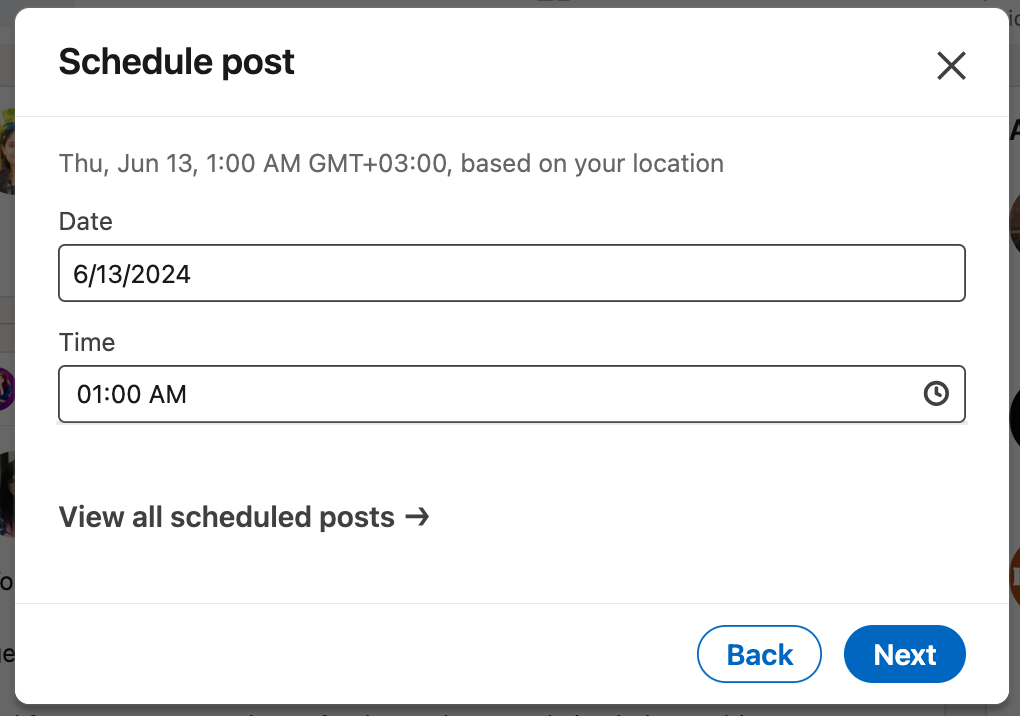
5. Select Next to save your schedule settings and return to your post preview.
6. When you’re all done, review your post for spelling errors, formatting issues and make sure it matches your brand’s guidelines and tone. Also, review your image and hashtags so they’re accurate for your post.
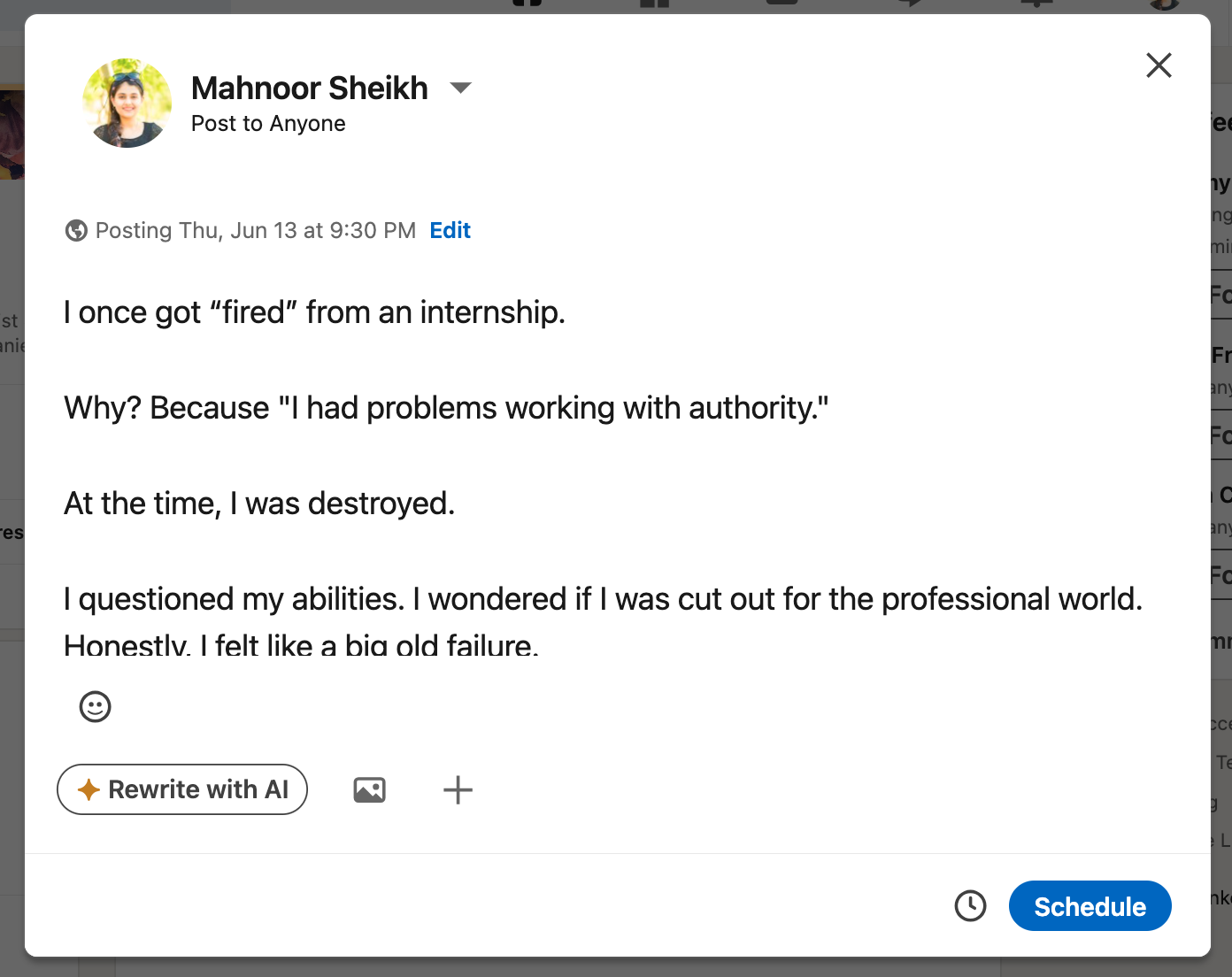
7. Click the Schedule button, and you’re done.
That’s it. You’ve scheduled your first post on LinkedIn.
Limitations with the native LinkedIn scheduler
While it seems straightforward to schedule content with LinkedIn’s native scheduler, there are several limitations that social media managers should be aware of. These limitations may hinder your ability to schedule posts effectively, especially if you’re using LinkedIn for business.
- Limited scheduling options: LinkedIn’s native scheduler provides fewer options for scheduling posts. For instance, it only allows scheduling for up to three months in advance. Also, LinkedIn doesn’t allow bulk scheduling, which means that each post must be scheduled individually.
- Limited analytics features: LinkedIn’s analytics only provide a basic insight into your LinkedIn content performance and audience behavior. It doesn’t give you much freedom to track your audience demographic data or metrics like click-through rates, follower growth or engagement rates.
- No support for managing multiple LI accounts at once: With the native LinkedIn scheduler, you can only schedule posts for one account at a time. This is a drawback, especially for social media managers who manage multiple accounts.
- Limited posting options: You can’t schedule events, jobs or services with the LinkedIn scheduler. This has to be done manually.
- Limitations on approval collaboration: The LinkedIn scheduler discourages the collaboration of teams in real-time. Posts can only be made and seen by one person, so every review, approval or collaboration must be done outside the tool.
- Posts cannot be edited after uploading: If you’re wondering how to edit scheduled posts on LinkedIn, you can’t do so using the native scheduler. Once a post has been scheduled for upload, it cannot be edited. In the event that any corrections need to be made, you’d need to delete the entire post and repost it.
How to see scheduled posts on LinkedIn
LinkedIn allows you to view your scheduled posts so you can delete or reschedule them. Follow the steps below to see your scheduled posts.
1. Click the Start a post box at the top of your LinkedIn feed.
2. Navigate to the Clock icon at the bottom-right of the Create a box pop-up.
3. Click View all scheduled posts to see all your scheduled posts and their publish dates.
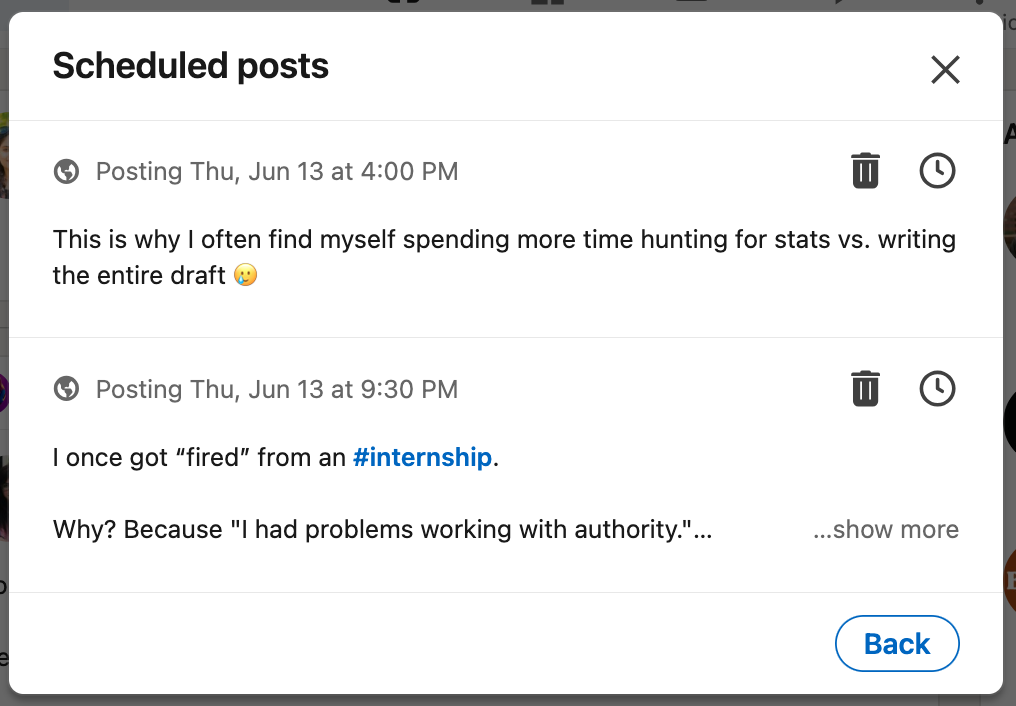
4. To delete a post, simply click on the delete icon, and if you want to reschedule, click on the clock icon to select a new date and time.
How to schedule posts on LinkedIn using Sprout Social
LinkedIn’s native scheduling tool is great, but if your business is active on multiple platforms, you might need a more robust solution to handle your social media strategy, like Sprout Social.
Sprout’s powerful social media publishing tool makes it easy to cross-post on different platforms, collaborate with your team, set permissions and access in-depth analytics—all from one central hub.
You can schedule posts on LinkedIn using Sprout from both desktop and mobile. Just upload your content, add images, links and videos, and then schedule your post when it’s ready to go.
Here’s how to do it:
1. Create your LinkedIn post
The first step is to create your post. Before writing, be clear on the goal of the post and how it’ll benefit your audience. A good LinkedIn post starts with an attention-grabbing hook, which could be a question, a story, a compelling statement or a relevant statistic.
On the Sprout dashboard, click the Compose icon to draft a new post. Input your post in the text box provided and format it for a better reading experience. You can also add emojis, links and relevant LinkedIn hashtags to your post.
On the right side, you can preview changes to your posts to see the outcome on LinkedIn in real-time.
2. Add media to your post
Upload approved media content to your post to make it stand out. This could be a single image, multiple images or a video to enhance your post and make it stand out.
If you’re publishing an image or a video, you can add alt tags for your images, upload an SRT file for video subtitles and even add a custom video thumbnail.
After uploading, you can edit your images on Sprout with the integrated image editor tool or resize them using our social media resizer.
Here, you can crop the image size and add filters, frames, new texts, overlays or stickers. Once you’re done, export the image to save your changes.
3. Preview and optimize your post
After editing your post, click the profile picker to select the LinkedIn profile for your post. Sprout Social allows you to manage multiple LinkedIn (and other social media) accounts at once and lets you post to a LinkedIn company or personal page.
If you’re posting from a company page, you can also tweak the audience targeting settings to ensure your posts show up in front of the right people.
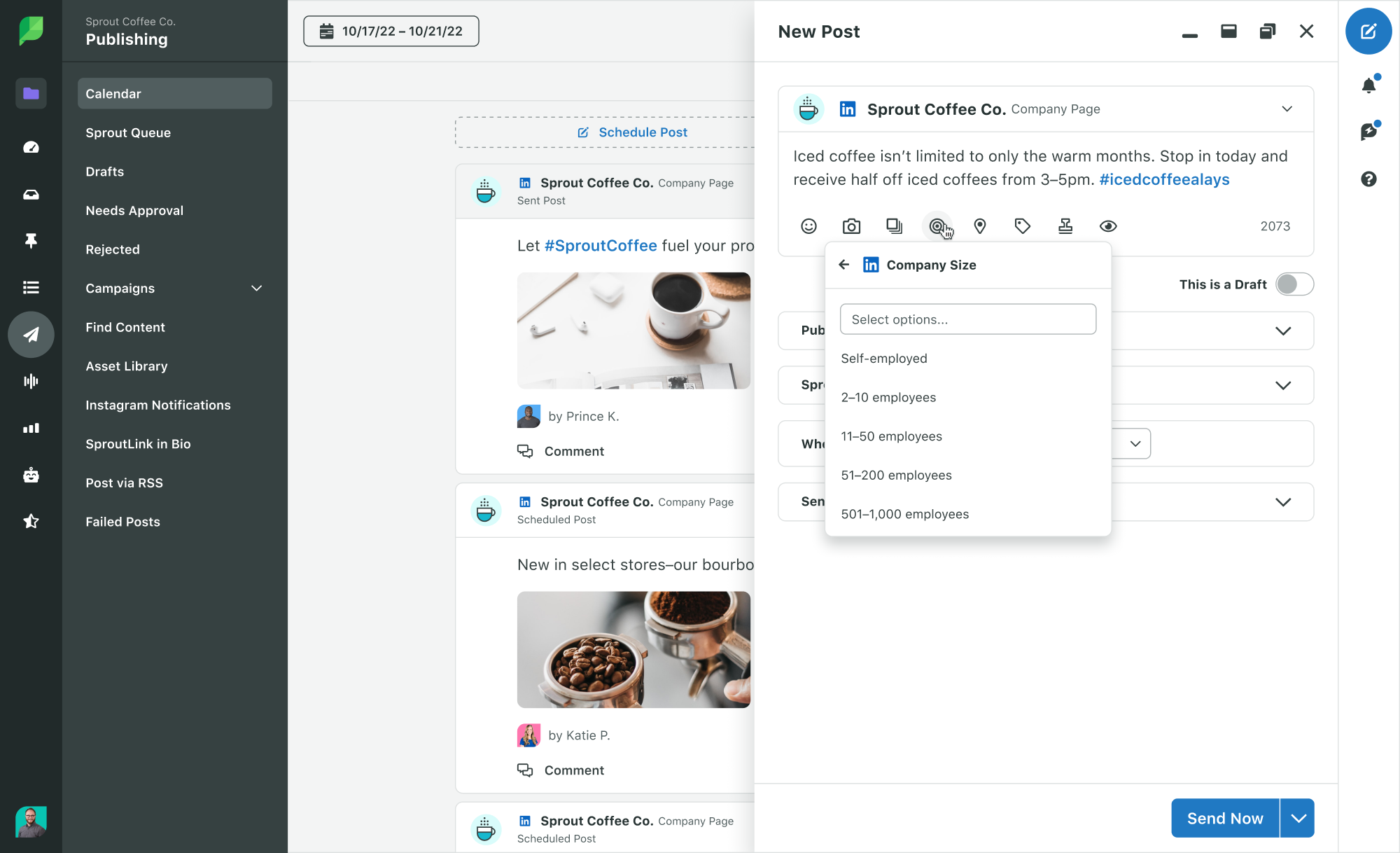
Set up approval permissions for collaboration and approval of each post. This is useful for social media teams and marketers who need their clients’ or managers’ feedback on posts before they go live.
4. Finalize your post
After your content is optimized, you can submit your post for approval and save it as a draft. Posts that need approval can be saved as drafts until all reviews are complete.
On Sprout’s calendar, you can view, share and collaborate on your monthly scheduled content in a calendar view. You can add notes to each comment from another team member. And if you’re bulk scheduling your posts, you can view all your scheduled posts at once and correct them accordingly.
5. Schedule your post for publishing
Once you’re all set, select when you want the post to go out. You can publish your post immediately, auto-schedule with Sprout Queue or schedule it for later.
Pick a specific date and time to schedule your posts. Better yet, take advantage of Sprout’s tool, ViralPost, to pick optimal times when your audience is most active on LinkedIn.
You can also auto-schedule your posts with Sprout Queue to fill engagement gaps and publish posts automatically throughout the day. You don’t need to input a time or day when the post will go live; Sprout Queue takes care of that for you.
Why should you schedule your posts on LinkedIn?
Scheduling your LinkedIn posts allows you to optimize the execution of your LinkedIn strategy, which provides an efficient means to distribute your content on the platform effortlessly.
1. Saves time and reduces unnecessary workload
Establishing a LinkedIn presence requires much time, effort, and dedication, which is time-consuming. By scheduling posts, you spend less time on manual publishing on LinkedIn, freeing you up to focus on higher-level tasks such as content creation, analysis, and engagement.
2. Helps you stay consistent
Scheduling your posts allows you to plan content in advance and set them to post at the right times. This way, you maintain a consistent LinkedIn presence without staying on the platform or worrying about posting daily.
3. Grow your profile engagement faster
Scheduling your LinkedIn posts will help you reach your audience at the best times when they’re most active on LinkedIn. When scheduling your post, you can choose the best time when your audience will be available and target your posts to show up at that time, thereby increasing engagement.
4. Keeps you organized
Keeping track of your LinkedIn account can be stressful, especially if you manage multiple accounts simultaneously. Scheduling your posts takes the burden off of that. All you need to do is create your posts and schedule a publishing time.
5. Helps you scale your LinkedIn efforts
Growing your audience on LinkedIn comes with much dedication and time. Scheduling makes it easier. When you schedule your posts, it gives you the advantage of posting consistently and growing your account.
5 tips for scheduling your LinkedIn posts
Ready to start scheduling your LinkedIn posts? Consider these five tips to help you effectively set your posts up for maximum success.
1. Know your audience
Before posting on LinkedIn, define who your ideal audience is. You need to know: who are you talking to? What do they do? What do they like? A generic response like “CEOs” or “marketers” won’t do. You must dive deeper and answer specific questions like:
- Location: Get clear on your audience’s location so you can customize posting times to when they’re most active.
- Professional details: Find out what they do and their position.
- Buying power: Find out their role in the buying process. For example, content heads often suggest project management software for their team.
- Industry: What industry are they currently in? Do they use familiar lingo?
- Online behavior: Pay attention to the type of content they engage with. Find out what content gets the most shares, likes, comments and reposts. This will give you an idea of what topics and content types resonate with your audience.
With Sprout Social’s AI listening tool, you can collect in-depth data about your audience. Dig into demographics and preferences, track conversations, analyze sentiment around specific topics, and even keep an eye on your competition to truly understand your target audience.
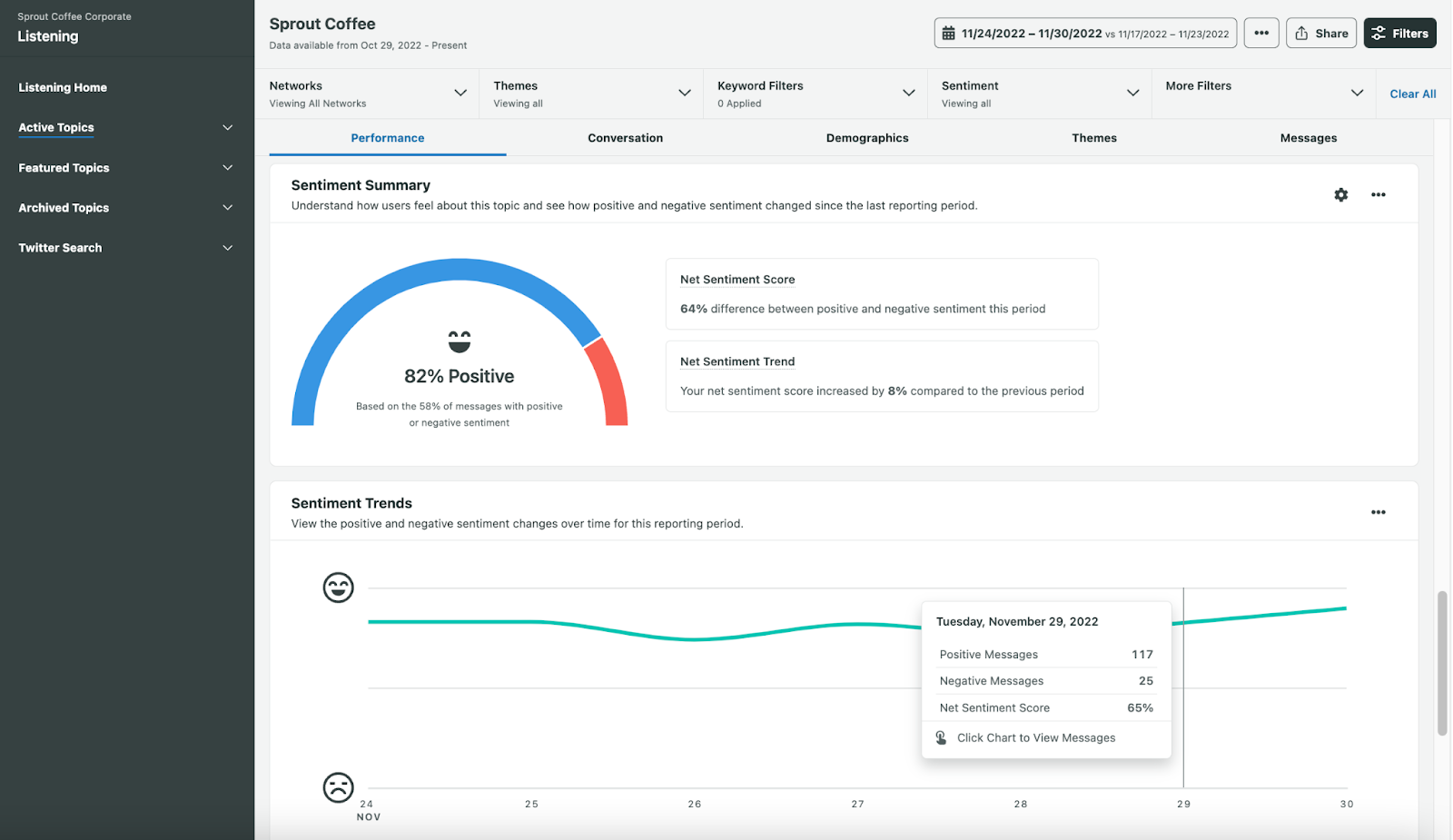
2. Post at the right time
The best time to post on LinkedIn is during optimal hours, when your audience is most active and likely to engage with your post. Our research at Sprout Social found that the best time to post on LinkedIn, on average, is 10 a.m. on Tuesday.
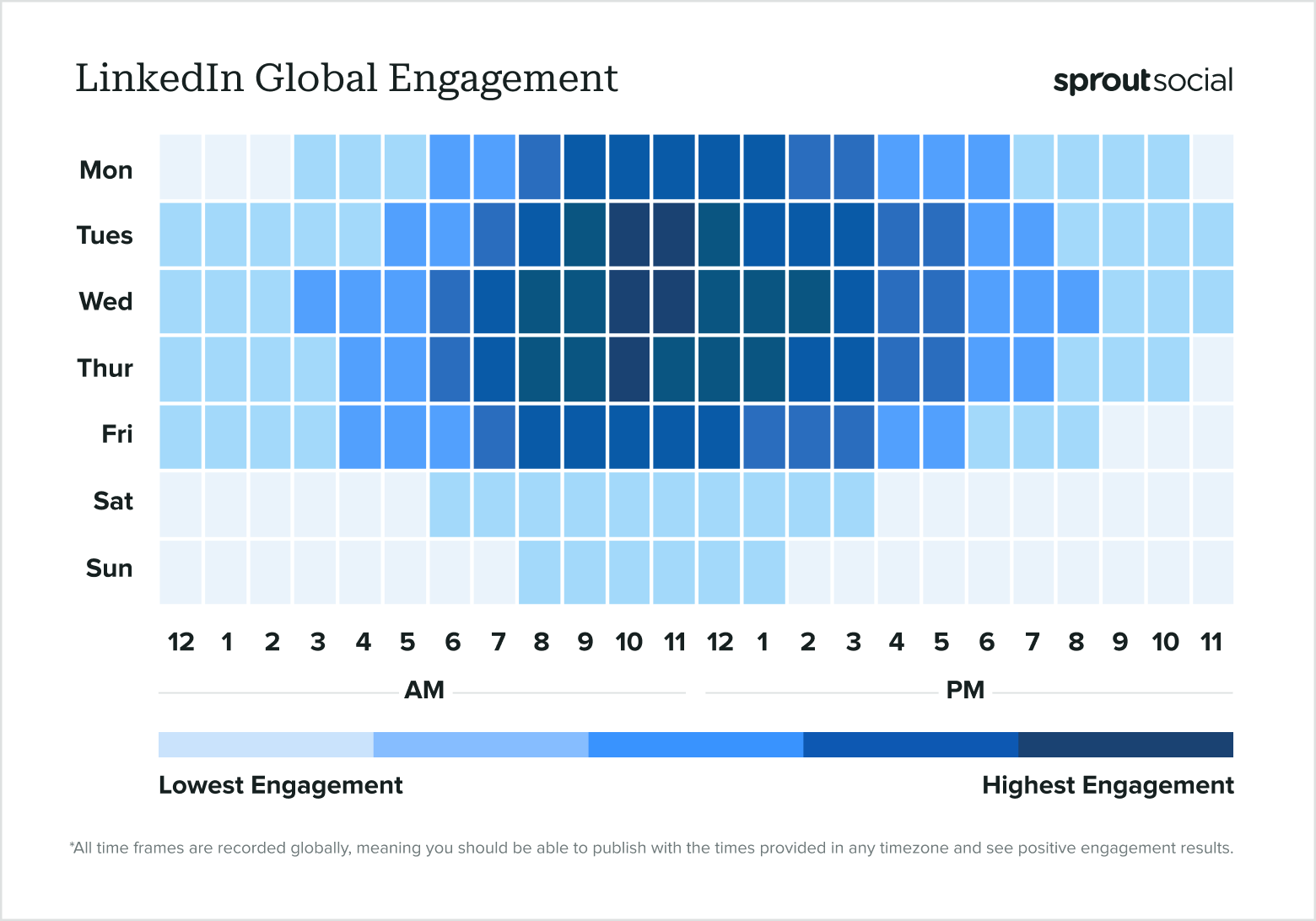
However, don’t let this restrict your posting schedule to this time as the best times to post can vary depending on industry and demographics. Keep a close eye on your LinkedIn analytics to determine which posts perform well and adjust your posting schedule accordingly.
3. Experiment with different content types
The best post types on LinkedIn can differ depending on your industry. We studied 3,000 LinkedIn posts and found that long-form “how-tos” perform 31.5% better than every other content type. This is unsurprising, as LinkedIn is a community of professionals who share ideas and learn from one another.
However, we also found that posts with a single image perform 2x better than text-based posts and have a 98% higher comment rate, whereas posts with videos get 5x more engagement on LinkedIn. This means uploading video content from webinars or tutorials would perform well on LinkedIn.
In our 2024 Content Benchmarks Report, we also dug into content formats consumers want brands to share more of on social media, not just LinkedIn.
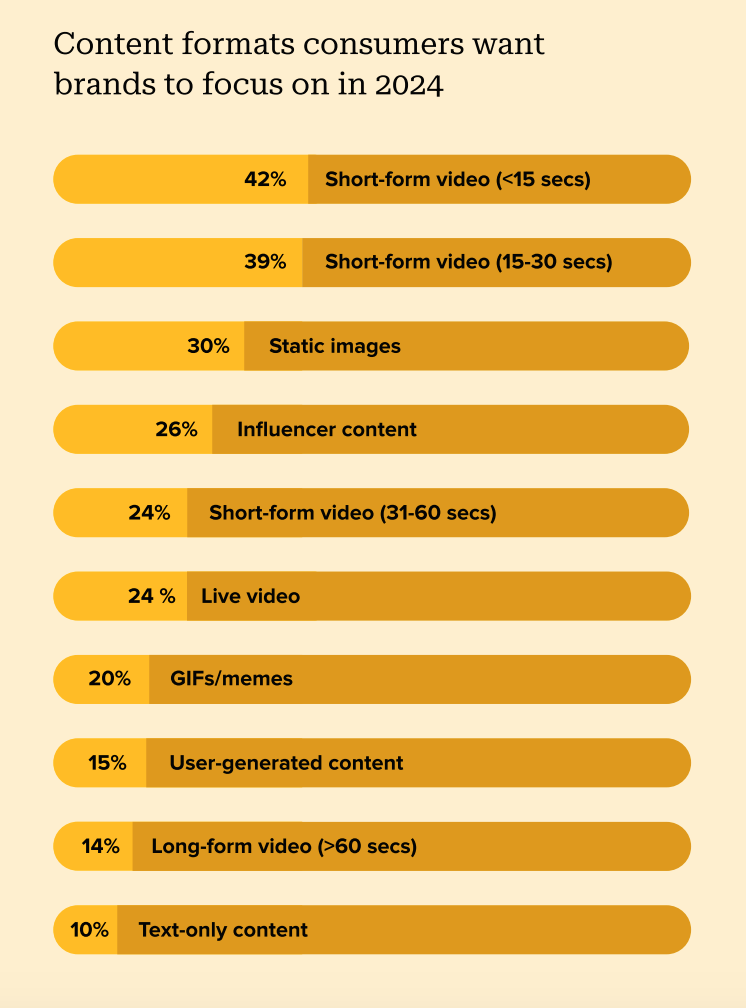
Experiment with different post formats to find your audience’s sweet spot for engagement. Depending on the vibe, you could choose to alternate content types for each posting day.
For example, posting a meme gives off a relaxed feeling, which fits into a weekend mood. Meanwhile, text-based posts, videos or slides would fit well for other days.
But if you’re still clueless about what to post on your company’s page, check out this post on LinkedIn’s best practices for marketing professionals.
4. Take time to engage with your audience
Scheduling a post is one part of a successful LinkedIn strategy; the other is engaging with your audience. Engaging with your audience humanizes your brand and fosters a positive customer relationship. This helps you gain credibility, build authority and increase brand loyalty.
More importantly, engagement is what your customers really want from you. According to Sprout’s research, 37% of consumers think the most memorable brands prioritize direct audience engagement over publishing lots of posts.
Also, engaging with your audience increases your account’s visibility on the channel. Think of it this way: the more you show up in the comment section, the more people engage with you, which gets more eyeballs on your profile.
You can engage with your audience by:
- Leaving meaningful comments on people’s posts
- Reposting content that’s meaningful and true to your brand
- Replying to comments on your posts
- Responding to questions, comments and messages
5. Optimize your LinkedIn marketing strategy with data
At intervals, study your LinkedIn analytics to measure what’s working and what’s not, so that you can adjust your content accordingly. Sprout Social provides in-depth social media analytics and reporting capabilities to help you measure your content performance, track your brand mentions and monitor your competition.
Don’t just create multiple posts in advance without looking at past results. Leverage data to:
- Analyze your best-performing posts and how you can re-create them for more success.
- Break down your least-performing posts and list possible mistakes.
- Optimize your LinkedIn strategy to suit the audience’s needs.
Optimize your LinkedIn strategy with scheduled posts
Scheduling your LinkedIn posts is a great way to plan your content in advance and boost engagement on the platform. Without it, you’ll have to manually post your content on LinkedIn, which can be time-consuming and make it harder to stay consistent.
Regardless of how good you think your LinkedIn content strategy is, it’s always best to schedule posts in advance, especially if you’re planning to scale your business or simply want to dedicate more time to strategic tasks like creating and analyzing content.
Sprout Social’s LinkedIn scheduler makes it easy to schedule posts on LinkedIn. Plus, you get additional features like in-depth analytics, social listening, automation and more. Sign up for a free 30-day trial today!
FAQs for scheduling posts on LinkedIn
Is there a free LinkedIn scheduler?
Yes, LinkedIn offers a free, built-in scheduling tool that allows you to schedule posts directly on the platform. This feature is available to all users at no additional cost.
Why can’t I schedule a post on LinkedIn?
If you’re having trouble scheduling a post on LinkedIn, make sure you’ve completed all the required fields like post content, and double-check that you’ve selected a valid date and time for your post to go live. Also note that LinkedIn currently does not support scheduling events, jobs and services.
Does scheduling LinkedIn posts affect engagement?
Scheduling your LinkedIn posts does not directly have a negative impact on engagement. However, if you schedule your posts to go live at a time when your audience is inactive, you might see a drop in engagement levels. Make sure to schedule your posts for times and days when your audience is most active to maintain or even increase your engagement.

